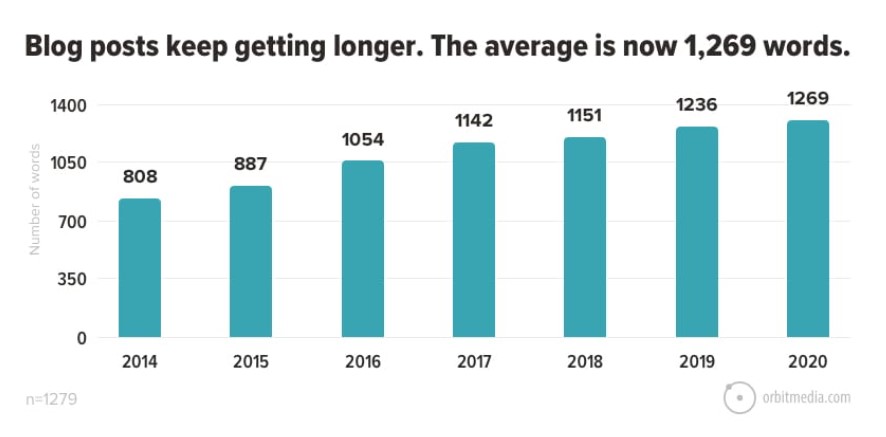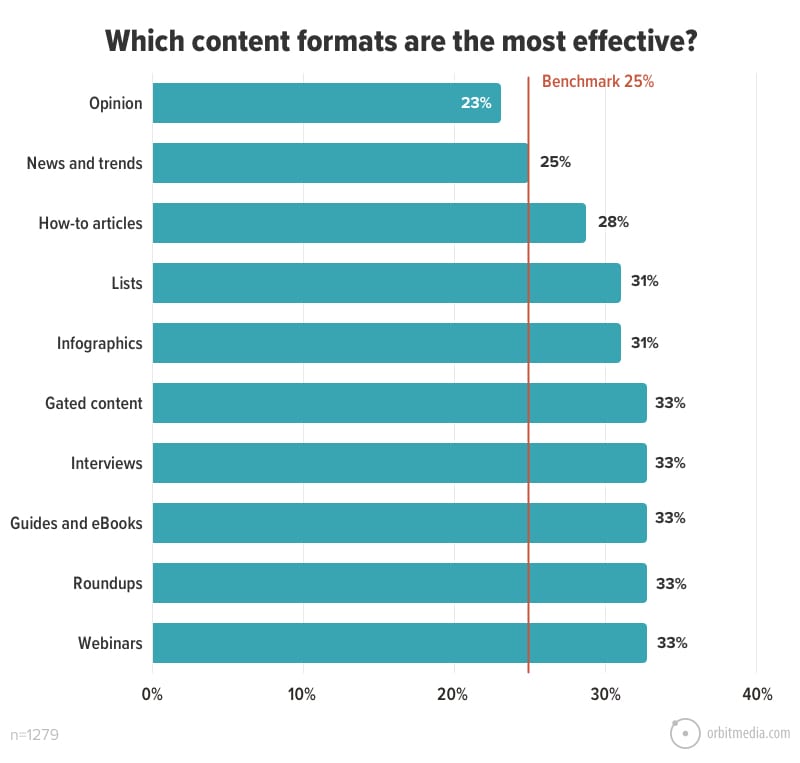Blogging is an industry all on its own. Gone are those days when blogging was a pastime for stay-at-home moms or a way for your kid brother to share the best game moves with his buddies.
At the beginning of 2021 there were over 600 million blogs on the internet, with an average of 6.91 million blog posts published daily worldwide. Let that sink in. It means that there are around 4,800 posts happening in the world each minute!
Don’t stop reading now though. In this article we’ll provide you with a whole lot more information that may just surprise you. For example, how long does it take the average blogger to write a post? And how are bloggers driving traffic to their blogs? We’ll give you those answers and a whole lot more stats and facts that will make bloggers think.
01. How Long Does It Take to Write a Blog Post?
It takes the average blogger close to 4 hours to write a post. Considering the average blog post is 1,269 words, this means that, if you’re average, you’re writing 5.4 words per minute. There’s got to be some research time included in there!

02. Short Form or Long Form Posts?
Back in 2014 there was a trend towards shorter posts (< 500 words) but this has shifted more towards longer form posts every year. In 2020 more bloggers write posts of over 2000 words than those writing shorties of less than 500 words.
The feedback from bloggers is that writing more means better results. Bloggers writing posts of over 3000 words are happier with their results than any others. So consider this: If you write a 3000 word post at an average of 5.4 words per minute, you’ll spend 9 hours and 15 minutes on your post. More haste, less speed, better results?

03. Publish and Relax?
66% of bloggers these days only publish a few posts a month compared with 2014, when most were posting a few times a week. Are they wise? Apparently not. Daily bloggers are the most likely to report “strong results” than any others, with inconsistent bloggers reporting, well, more inconsistent results.
Is it, therefore, safe to assume that posting more content (both in length and frequency) delivers better results? The stats appear to indicate this…
04. How to List or Not to List?
“How-to” posts are immense in blogging. In fact, they’re immensely popular too. 77% of bloggers favour “How-to” posts over any other type. Lists follow in a distant second place, 20% off the pace. If you’re waiting for news or trends, you’ll have to wait for less than 50% of those posting to provide it.
Interestingly, when considering the above, “How-to” posts are only rated as the most effective type of post by 28% of bloggers, with lists only slightly better off with 31%. The type of posts rated as most effective are gated content, interviews, guides and ebooks, roundups and webinars. Perhaps the competition to be the “How-to” king of the castle means you’re destined to remain picking up hay in the fields? Competition is great though, so keep trying!

05. Should I Pop a Selfie in?
90% of bloggers feature images in their posts with over 50% sharing statistics of some kind. Videos are regularly posted by just a quarter of posters.
Perhaps it’s time for a rethink? Video content drives results best for 39% of bloggers, with statistics and contributor quotes next best. Only 25% of bloggers feel that images drive results. Another fact though: if you’re going with images in your post, be brave. Bloggers with 10+ images in a post report stronger results than those with any less.
But it’s no to that selfie… unless your blog is all about you!

06. Have I Drafted Enough Headlines Yet?
It seems that drafting between 10 and 20 headlines before choosing the best one is most effective result-wise, but we must all be lethargic as most of us bloggers only draft 2 or 3. Go figure.
If we’re going to be lethargic we might as well type longer headlines.. Hubspot says that the ideal blog post headline length is 60 characters, and it’s probably good to throw a hyphen in there somewhere to make it easier for your readers to interpret. And include a few words that are the most popular, like “how”, “your”, “what”, “best”, “why” and “tip”. Just saying…

07. Am I Using Enough from Other Sources?
As far as the statistics are concerned, you may be using too much! Original content seemingly the way to go in your posts, with more and more conducting unique research for their posts. Citing data from other renowned and knowledgeable sources is not a bad thing at all, with most of the internet’s blog content still sourced in this way. BUT original blog content is growing, meaning that more time is spent on research and a lot more uncommon content is happening.
Bloggers researching and posting unique content are 32% more likely to produce “strong results”. It makes you think, doesn’t it? Or you could source it elsewhere instead…

08. Social Media Again?!!
Social media can be annoying for individuals. For business it’s an entirely different animal though with 94% of bloggers driving traffic to their content via social sources. Email marketing and SEO are considered the next popular traffic-driving methods, both coming in with above 60%.
When the question surrounding results arises though, bloggers feel that influencer outreach, paid services, SEO and email marketing are all more effective than social media in getting results. A conundrum again… put in significant work socially to gain the effectivity you may have through influencer outreach and a little less personal effort? It’s probably best not to think “either-or” but rather to find the happy “mediums” that work for you! See what I did there?

09. Google Analytics? What’s That?
Only about half of current bloggers keep an eye on their analytics consistently. Which isn’t actually different to those who did way back in 2014? The question is why? Or actually why not?
Considering that 37% of bloggers who do use analytics believe that they are always more successful due to this, it seems a “no brainer”. Analytics provide the information regarding how users are interacting with your content, so how could this not be useful and beneficial?

10. Is It Worth Updating That Post from Last Year?
More and more bloggers are going back and updating their older content. In fact, 17% more bloggers are doing this since 2017 and it seems that, strategically, this is very beneficial.
30% of bloggers update their older posts and feel it is successful, whereas only 13% who don’t feel they’re experiencing success. Could updating and reposting older content really help? If the old content is still relevant and the added newer content makes it even more so, where’s the harm? Clearly there is a benefit – the stats have spoken.

More Interesting Facts:
- 54 % of bloggers have editors or have shown their work to someone else for review.
- There are 434% more index pages among websites that also contain a blog.
- 77% of internet users are blog readers.
- Content creation is described as their most constructive SEO tactic by 72% of online marketers.
- Blogging businesses have twice as much email traffic.
- 60% of blogs write 1-5 guest posts per month.
- Guest content is “too promotional” for 79% of editors.
- Since 2015, blogging has grown by over 12%.
- 69% of bloggers admit to using social share buttons.
- At present there are just under 1.9 billion web pages worldwide.
Summary
Those are some facts and stats that will make bloggers think. If they don’t you need to ask yourself, as a blogger, why? Feedback from our peers is often some of the best research that can be carried out as the relevance these carry for the blogging industry are thought-provoking and often actionable.
References
Graphics & Statistics – Andy Crestodina & Orbit Media
Facts & Statistics – optinmonster
Statistics – Internet Live Stats
Facts – Finances Online
- Technology and the future of books - July 29, 2021
- The benefits and importance of UX writing - July 29, 2021
- Use the science of music as a tool to enhance creative productivity - July 28, 2021